Papers by debatri chattopadhyay
arXiv (Cornell University), Jul 11, 2024
arXiv (Cornell University), Jun 10, 2024
arXiv (Cornell University), May 6, 2024
arXiv (Cornell University), Oct 2, 2023
Upload_1: COMPAS data for all simultions used in the paper
The Astrophysical Journal, Aug 1, 2022
Data associated with candidates in GWTC-2.1. These are gravitational-wave candidates from the fir... more Data associated with candidates in GWTC-2.1. These are gravitational-wave candidates from the first half of the third observing run (O3a) of the Advanced LIGO and Virgo detectors that pass a false alarm rate threshold of 2/day. We upload a tar file (search_data_GWTC2p1.tar.gz) containing all the data and a python notebook (search_data.ipynb) which provides description on how to use the files contained in the dataset.
Physical review, Jul 12, 2022
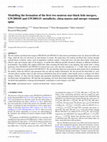
The two neutron star-black hole mergers (GW200105 and GW200115) observed in gravitational waves b... more The two neutron star-black hole mergers (GW200105 and GW200115) observed in gravitational waves by advanced LIGO and Virgo, mark the first ever discovery of such binaries in nature. We study these two neutron star-black hole systems through isolated binary evolution, using a grid of population synthesis models. Using both mass and spin observations (chirp mass, effective spin and remnant spin) of the binaries, we probe their different possible formation channels in different metallicity environments. Our models only support LIGO data when assuming the black hole is non spinning. Our results show a strong preference that GW200105 and GW200115 formed from stars with sub-solar metallicities $Z\lesssim 0.005$. Only two metal-rich ($Z=0.02$) models are in agreement with GW200115. We also find that chirp mass and remnant spins jointly aid in constraining the models, whilst the effective spin parameter does not add any further information. We also present the observable (i.e. post selection effects) median values of spin and mass distribution from all our models, which maybe used as a reference for future mergers. Further, we show that the remnant spin parameter distribution exhibits distinguishable features in different neutron star-black hole sub-populations. We find that non-spinning, first born black holes dominate significantly the merging neutron star-black hole population, ensuring electromagnetic counterparts to such mergers a rare affair.

This data set is used to produce Figure 16 of the COMPAS Paper (Team COMPAS et al. 2021). The fil... more This data set is used to produce Figure 16 of the COMPAS Paper (Team COMPAS et al. 2021). The file contains the output of 10,000,000 binaries evolved using COMPAS v02.21.00, using adaptive importance sampling (STROOPWAFEL) , sampling from a metallicity uniform in \(\log(Z) \in [10^{-4},0.03]\). More details can be found in the `Run_Details` group. *****************************<br> Contents<br> ***************************** COMPAS simulation output:<br> The hdf5 file Includes necessary information about the simulated binaries in the following groups:<br> <br> <strong>BSE_Double_Compact_Objects<br> BSE_Common_Envelopes<br> BSE_RLOF<br> BSE_Supernovae<br> BSE_System_Parameters<br> Run_</strong><strong>Details</strong><br> <br> We point the reader to the documentation at https://compas.science/docs, for information and instructions regarding the contained data.<br> <strong>Rate Da...
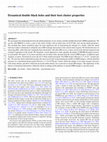
We investigate the relationship between the global properties of star clusters and their double b... more We investigate the relationship between the global properties of star clusters and their double black hole (DBH) populations. We use the code NBODY6 to evolve a suite of star cluster models with an initial mass of O(104)M and varying initial parameters. We conclude that cluster metallicity plays the most significant role in determining the lifespan of a cluster, while the initial half-mass radius is dominant in setting the rate of BH exchange interactions in the central cluster regions. We find that the mass of interacting BHs, rather than how frequently their interactions with other BHs occur, is more crucial in the thermal expansion and eventual evaporation of the cluster. We formulate a novel approach to easily quantify the degree of BH-BH dynamical activity in each model. We report 12 in-cluster and three out-of-cluster (after ejection from the cluster) DBH mergers, of different types (inspiral, eccentric, hierarchical) across the ten N-body models presented. Our DBH merger effi...
This contains the data behind the paper "Binary population synthesis with probabilistic remn... more This contains the data behind the paper "Binary population synthesis with probabilistic remnant mass and kick prescriptions"<br> <br> See https://github.com/TeamCOMPAS/COMPAS for code information and instructions on parsing the data.
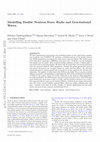
We have implemented prescriptions for modelling pulsars in the rapid binary population synthesis ... more We have implemented prescriptions for modelling pulsars in the rapid binary population synthesis code COMPAS. We perform a detailed analysis of the double neutron star (DNS) population, accounting for radio survey selection effects. The surface magnetic field decay timescale (∼1000 Myr) and mass scale (∼0.02 M_) are the dominant uncertainties in our model. Mass accretion during common envelope evolution plays a non-trivial role in recycling pulsars. We find a best-fit model that is in broad agreement with the observed Galactic DNS population. Though the pulsar parameters (period and period derivative) are strongly biased by radio selection effects, the observed orbital parameters (orbital period and eccentricity) closely represent the intrinsic distributions. The number of radio observable DNSs in the Milky Way at present is about 2500 in our model, corresponding to approximately 10% of the predicted total number of DNSs in the galaxy. Using our model calibrated to the Galactic DNS ...
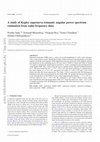
Supernova remnants (SNRs) have a variety of overall morphology as well as rich structures over a ... more Supernova remnants (SNRs) have a variety of overall morphology as well as rich structures over a wide range of scales. Quantitative study of these structures can potentially reveal fluctuations of density and magnetic field originating from the interaction with ambient medium and turbulence in the expanding ejecta. We have used 1.5GHz (L band) and 5GHz (C band) VLA data to estimate the angular power spectrum C_ℓ of the synchrotron emission fluctuations of the Kepler SNR. This is done using the novel, visibility based, Tapered Gridded Estimator of C_ℓ. We have found that, for ℓ = (1.9 - 6.9) × 10^4, the power spectrum is a broken power law with a break at ℓ = 3.3 × 10^4, and power law index of -2.84± 0.07 and -4.39± 0.04 before and after the break respectively. The slope -2.84 is consistent with 2D Kolmogorov turbulence and earlier measurements for the Tycho SNR. We interpret the break to be related to the shell thickness of the SNR (0.35 pc) which approximately matches ℓ = 3.3 × 10^...

The Astrophysical Journal Supplement Series, 2022
Compact Object Mergers: Population Astrophysics and Statistics (COMPAS; https://compas.science) i... more Compact Object Mergers: Population Astrophysics and Statistics (COMPAS; https://compas.science) is a public rapid binary population synthesis code. COMPAS generates populations of isolated stellar binaries under a set of parameterized assumptions in order to allow comparisons against observational data sets, such as those coming from gravitational-wave observations of merging compact remnants. It includes a number of tools for population processing in addition to the core binary evolution components. COMPAS is publicly available via the GitHub repository https://github.com/TeamCOMPAS/COMPAS/, and is designed to allow for flexible modifications as evolutionary models improve. This paper describes the methodology and implementation of COMPAS. It is a living document that will be updated as new features are added to COMPAS; the current document describes COMPAS v02.21.00.

The Astrophysical Journal, 2022
The LIGO/Virgo gravitational-wave observatories have detected at least 50 double black hole (BH) ... more The LIGO/Virgo gravitational-wave observatories have detected at least 50 double black hole (BH) coalescences. This sample is large enough to have allowed several recent studies to draw conclusions about the implied branching ratios between isolated binaries versus dense stellar clusters as the origin of double BHs. It has also led to the exciting suggestion that the population is highly likely to contain primordial BHs. Here we demonstrate that such conclusions cannot yet be robust because of the large current uncertainties in several key aspects of binary stellar evolution. These include the development and survival of a common envelope, the mass and angular-momentum loss during binary interactions, mixing in stellar interiors, pair-instability mass loss, and supernova outbursts. Using standard tools such as the rapid population synthesis codes StarTrack and COMPAS and the detailed stellar evolution code MESA, we examine as a case study the possible future evolution of Melnick 34,...

Monthly Notices of the Royal Astronomical Society, 2021
Binaries comprised of a neutron star (NS) and a black hole (BH) have so far eluded observations a... more Binaries comprised of a neutron star (NS) and a black hole (BH) have so far eluded observations as pulsars and with gravitational waves (GWs). We model the formation and evolution of these NS+BH binaries – including pulsar evolution – using the binary population synthesis code COMPAS. We predict the presence of a total of 50–2000 binaries containing a pulsar and a BH (PSR+BHs) in the Galactic field. We find the population observable by the next generation of radio telescopes, represented by the SKA and MeerKAT, current (LIGO/Virgo) and future (LISA) GW detectors. We conclude that the SKA will observe 1–80 PSR+BHs, with 0–4 binaries containing millisecond pulsars. MeerKAT is expected to observe 0–40 PSR+BH systems. Future radio detections of NS+BHs will constrain uncertain binary evolution processes such as BH natal kicks. We show that systems in which the NS formed first (NSBH) can be distinguished from those where the BH formed first (BHNS) by their pulsar and binary properties. We...
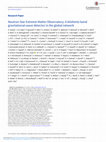
Publications of the Astronomical Society of Australia, 2020
Gravitational waves from coalescing neutron stars encode information about nuclear matter at extr... more Gravitational waves from coalescing neutron stars encode information about nuclear matter at extreme densities, inaccessible by laboratory experiments. The late inspiral is influenced by the presence of tides, which depend on the neutron star equation of state. Neutron star mergers are expected to often produce rapidly rotating remnant neutron stars that emit gravitational waves. These will provide clues to the extremely hot post-merger environment. This signature of nuclear matter in gravitational waves contains most information in the 2–4 kHz frequency band, which is outside of the most sensitive band of current detectors. We present the design concept and science case for a Neutron Star Extreme Matter Observatory (NEMO): a gravitational-wave interferometer optimised to study nuclear physics with merging neutron stars. The concept uses high-circulating laser power, quantum squeezing, and a detector topology specifically designed to achieve the high-frequency sensitivity necessary ...











Uploads
Papers by debatri chattopadhyay